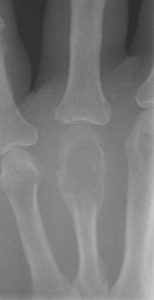Bone Diseases and Causes in Adults and Children

Millions of Americans are affected by bone diseases from various causes, the most common of which is osteoporosis. People with osteoporosis are at a high risk of fractures. Fractures are often disabling and lead to deterioration in the patient’s physical and mental health. Primary osteoporosis is the most common type of osteoporosis. It is the result of deteriorating bone structure and bone loss with aging. Primary osteoporosis can be prevented through proper nutrition, adequate physical exercise, and when necessary, appropriate treatment. Secondary osteoporosis is the result of other diseases that affect the bones and certain drugs and toxic substances that make bones weak. If secondary osteoporosis is recognized in time, it can be prevented with nutrition, physical activity, and treatment if needed.
X-ray techs can learn more about radiographic bone densitometry and its role in osteoporosis prevention through our 23-credit ARRT®-recognized course.
Bone Diseases and Causes in Children
A number of bone diseases and causes have been identified in children, a common one of which is rickets. Many conditions in children can cause rickets, the most common of which is vitamin D deficiency. Rickets is a disease characterized by a delay in the deposition of calcium and phosphate minerals in the child’s growing bones. This defective mineralization leads to skeletal deformities such as a characteristic bowing of the legs. The equivalent disease in adults is osteomalacia. Both rickets and osteomalacia are preventable by ensuring an adequate level of vitamin D. If left untreated, these conditions can have serious consequences.
Renal Osteodystrophy
People with chronic renal disease (progressive loss of kidney function) are at risk for developing a complex condition known as renal osteodystrophy. This is a well known bone disease and causes have been studied in detail. Dialysis and kidney transplantation may improve the life expectancy of a patient with chronic kidney disease. However, these treatments are not always successful in stopping the progression of renal osteodystrophy.
Paget’s Disease
Paget’s disease of the bone is a disorder of bone remodeling that is progressively crippling in affected individuals. Although it can occur in any bone in the body, it frequently involves the skull, spine, pelvis, and legs. Early diagnosis of Paget’s disease of the bone can minimize its impact.
Malignancies and Genetic Bone Diseases
A number of genetic diseases, syndromes, and developmental disorders affect the skeleton. One of the most common congenital disorders to affect bones is osteogenesis imperfecta (OI). People with OI have bones that fracture easily, hence the name “brittle bone disease.”
Bone malignancy is an acquired skeletal condition. The causes of this type of bone disease vary. Primary tumors originate in bone. More commonly, however, bones are the site of secondary tumors (metastatic deposits) as a result of seeding from primary tumors located elsewhere in the body. Children can develop primary bone cancers as well. In both adults and children, malignancies, both primary and secondary, can destroy bone.

The growth and maintenance of a healthy skeleton is regulated by many different systems in the body. Any disruption in these systems can result in bone disease. Problems in the bones can be present before birth (genetic abnormalities), during childhood (nutritional deficiency), or later in life (osteoporosis). Damage to the skeleton can occur at all stages of a person’s life. In addition to conditions that affect bones directly, many disorders have an indirect effect on the bones by interfering with mineral metabolism.
Get your radiography continuing education credits here.